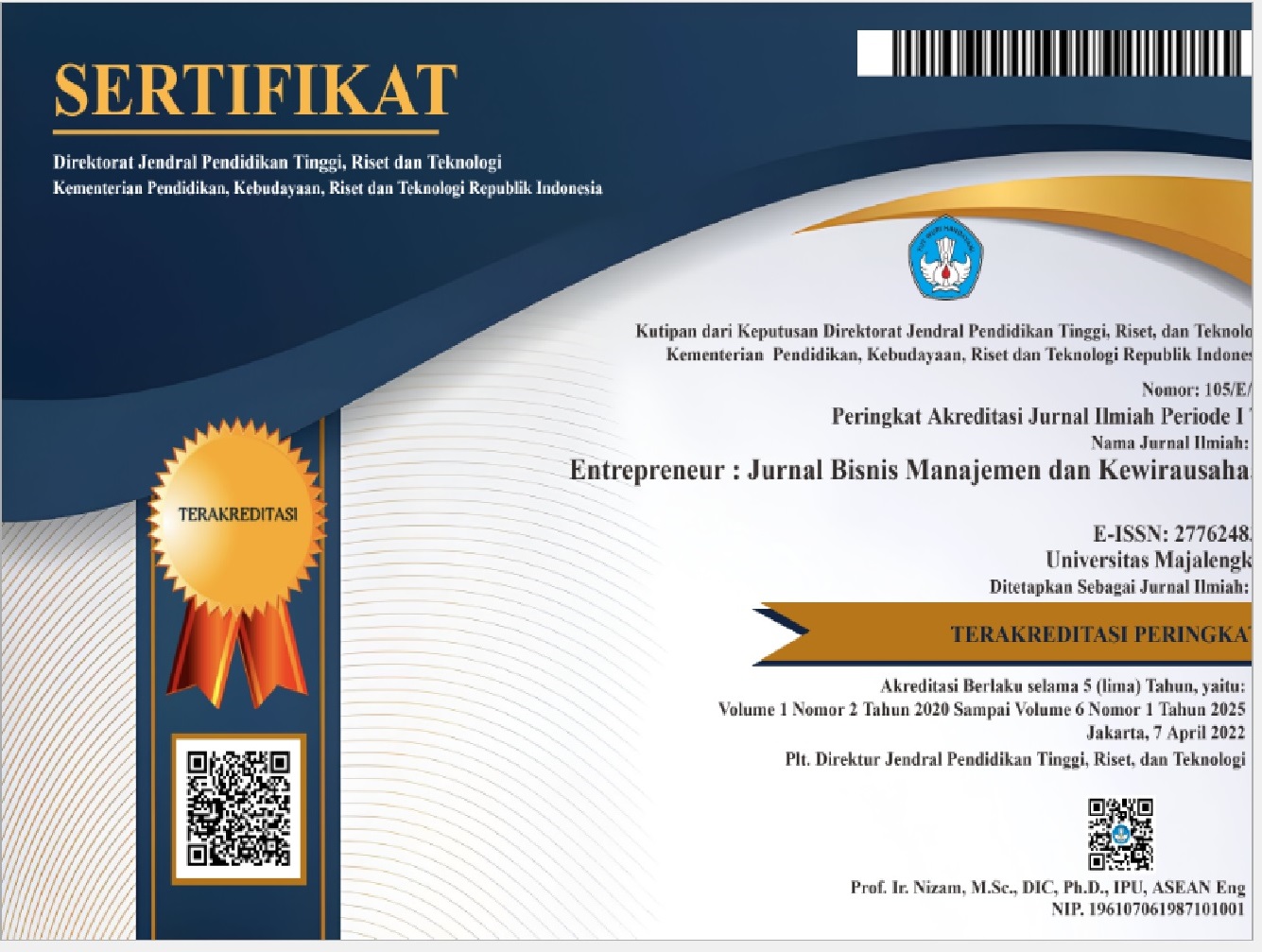Assesment Entrepreneurship Skills Literacy For Post Graduate Student's
DOI:
https://doi.org/10.31949/entrepreneur.v3i1.3793Abstrak
The success of the implementation of the Vision of the Master of Mathematics Education Study Program which is to produce graduates who are superior, nationally minded, and entrepreneurial can be identified using an instrument. One of the keywords in the Vision is graduates who have an entrepreneurial spirit. Developing an instrument to identify the Vision of the Study Program is an important thing to do. The research method used is development research (R&D) using the ADDIE model. The results of the field trial of research on 31 students showed that the average achievement of group skills was better than personal skills, but smaller than interpersonal skills. The results of expert validation stated that AESL was feasible to use with improvements. The results of the user response questionnaire stated that AESL was categorized as very good.
Kata Kunci:
Entrepreneurship, DevelopmentUnduhan
Referensi
Branch, Robert Maribe. 2009. Instructional Design: The ADDIE Approach. Springer: London
Consortium For Entrepreneurship Education. 2008. Entrepreneurship everywhere: The case for entrepreneurship education. Columby, USA.
Darudianto, Suparto., dkk. 2011. Membangun Customer Relationship Management Dalam Bisnis. Comtech, Vol 2, No 2, ISBN: 1350-1358
Gilad, B., and Levine, P. 1986. A behavioral model of entrepreneurial supply. Journal of Small Business Management, Vol. 24 No. 4, pp. 45-54.
Harvey, Satrina., Millett, Bruce., Smith, Don. 1998. Developing Successful Teams In Organisations. Australian Journal of Management&Organisational Behaviour, 1(1), 1-8
Holmgren, C., From, J., Olofsson, A., Karlsson, H., Snyder, K., & Sundtröm, U. (2004). Entrepreneurship education: Salvation or damnation? International Journal of Entrepreneurship, 8, 55-71.
Ion, Medar Lucian. 2015. Entrepreneurship Education And The Economy Vicious Circles. Academica Brancusi Publisher
Klerk, Saskia De. 2010. The Importance Networking as a Management Skills. South African Journal of Business Management.
Rahim, M.Afzalur. 2001. Managing Conflict In Organizations (Third Edition).: Quorum Books: London
Raposo, Mario & do Paco, Arminda MF. 2011. Entrepreneurship Education: Relationship Between Education and Entrepreneurial Activity. Psicothema
Septianti, Dian. 2016. Pengaruh Motivasi, Lingkungan Keluarga, dan Ekspektasi pendapatan Terhadap minat berwirausaha (Studi Kasus pada Mahasiswa Universitas Tridinanti Palembang). Jurnal Ilmiah Ekonomi Global Masa Kini VOL 7 No.03 Desember
Supeni, Retno Endah&Efendi, Muhammad. 2017. Minat Mahasiswa Dalam Berwirausaha Perguruan Tinggi Swasta di kabupaten Jember. Prosiding Seminar Nasional dan Call Paper Ekonomi dan Bisnis. ISBN 9786025617010. Hal 449-463
Tim. 2015. Laporan Analisis Perubahan Kurikulum Program Studi Pendidikan Matematika. FKIP UMSU
Veterans Helath Administration. 2014. Manage Stress Workbook. Departement of Veterans Affairs: U.S
Wasdani, KP. 2012. Opportunity Recognition (OR) Skills of Entrepreneur and Its Association With Their Paths to Business Ownership and Types of Innovation: an Empirical Investigation of SME Firms.
Wijaya. 2017. Analisis Faktor-Faktor yang Mempengaruhi Minat Berwirausaha (Studi Kasus Mahasiswa Fakultas Ekonomi Perguruan Tinggi Swasta Di Kabupaten Jember. Jurnal Ekonomi dan SDM MEI, 2017
Whetten, David A & Cameron, Kim S. 2011. Developing Management Skills. Pearson: United States of America
Diterbitkan
Cara Mengutip
Terbitan
Bagian
Lisensi
Hak Cipta (c) 2022 Khomsatun Ni'mah, Krisna Sujaya, Anita Eka Putri

Artikel ini berlisensiCreative Commons Attribution-ShareAlike 4.0 International License.
COPYRIGHT NOTICE
An author who publishes in the Entrepreneur: Jurnal Bisnis Manajemen dan Kewirausahaan agrees to the following terms:
1. Author retains the copyright and grants the journal the right of first publication of the work simultaneously licensed under the Creative Commons Attribution-ShareAlike 4.0 License that allows others to share the work with an acknowledgment of the work's authorship and initial publication in this journal
2. The author is able to enter into separate, additional contractual arrangements for the non-exclusive distribution of the journal's published version of the work (e.g., post it to an institutional repository or publish it in a book) with the acknowledgment of its initial publication in this journal.
3. The author is permitted and encouraged to post his/her work online (e.g., in institutional repositories or on their website) prior to and during the submission process, as it can lead to productive exchanges, as well as earlier and greater citation of the published work








